How To Clean A Very Dirty Pool
Have you ever watched dark clouds gather before a storm, and you shudder when you imagine the state in which your pool will be left when the rains subside, and the skies clear up? Storms and rain bring mud and dirt into your pool and it's every pool owner's nightmare.
Here, we make it easy for you to clean up your pool after dirty rains.
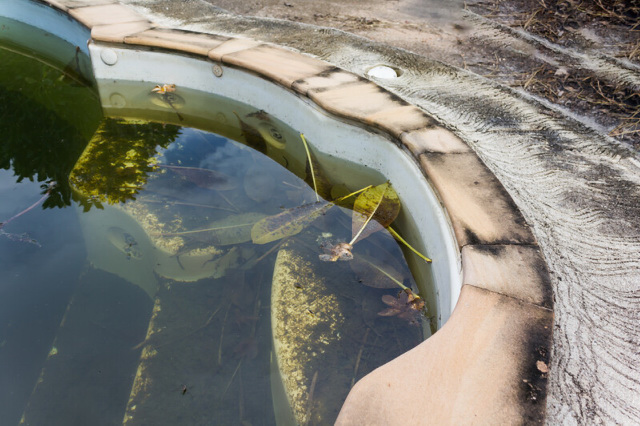
Brown Pool Water After Rain
There is no getting used to dirty or muddy pools because they are hectic to deal with, time-consuming, and generally expensive when you hire a cleaning company or pool pro.
Most of the mud and dirt in swimming pools result from heavy rains that wash and carry along with dust and debris only to deposit it in your pool.
And when you have a dirty muddy pool, then it means that you cannot swim for apparent reasons;
- For fear of filthy water on your skin
- The unsightly view of a muddy pool makes your skin crawl.
Muddy or dirty pool water needs to be cleaned and addressed ASAP.
Top Two Ways to Remove Mud & Dirt From a Pool
There are two ways to clean the mud out of your pool after rain and get that water clear again:
- Skimming, Vacuuming, Filtering & Floccing to Remove Mud
- Partial or Fully Draining to Remove Mud
As always with pools, start with the least drastic method. That is the no drain cleaning method. Here it is.
Method 1: No Drain Cleaning (Filter, Vacuum & Floc to Clean Mud)
They say there are many ways of killing a rat, and this one way of cleaning a muddy pool and removing the mud and dirt without draining off the water.
1. Start by Cleaning the Pool Surrounds
As always, clean the deck or pool surrounds before you zero in on the main problem. You don't want anymore mud, dirt or debris entering the pool.
2. Use a Skimmer Net to Clean the Water Surface
Go around the pool and manually collect as much floating debris as possible from the water using a skimmer. It's far easier to skim it off now then to try and vacuum it up later. It'll also keep the skimmer basket clear.
You can use this pool and pool (click to check the price).
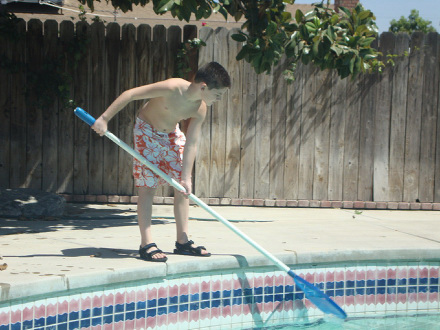
3. Add Chlorine & Lots of It
After a lot of organic matter enters your pool it's essential to boost the chlorine levels as soon as possible. This will help keep the water in check and reduce the likelihood of leaves and debris staining the pool bottom.
You can do this by adding liquid chlorine to bring the chlorine levels to between 10 ppm and 30 ppm. You will need to add a little stabilizer too to prevent the chlorine from dissipating too quickly.
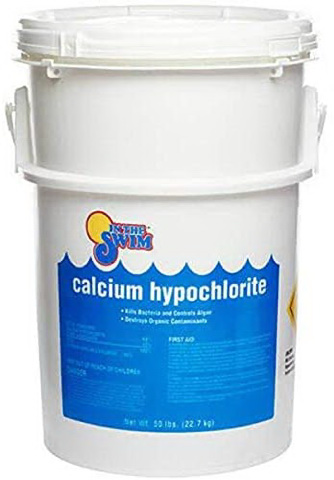
Click here to check price >>
4. Clean the Pool Floor with a Vacuum
The rain will have likely dumped all sorts of dirt, leaves and debris onto your pool floor too.
After getting done with the skimmer, you'll need a pool vacuum cleaner to do some cleaning. Dirt and mud have a way of sticking on the surface of the pool, so it's best to get it all out quickly.
For large debris, you can use a garden hose powered leaf vacuum like this. This particular model has a large debris bag which means you won't be continually emptying it. And it runs off of a garden hose – so if you don't have a pool filtration system, you can still use it.
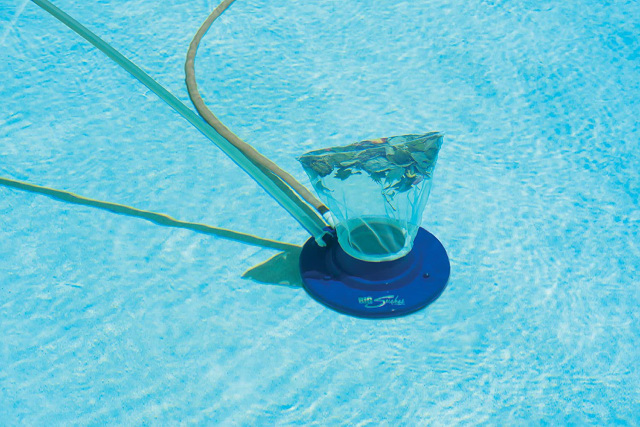
Click here to check price >>
If you prefer to use your pool's filter system, you can use a pool vacuum like this.
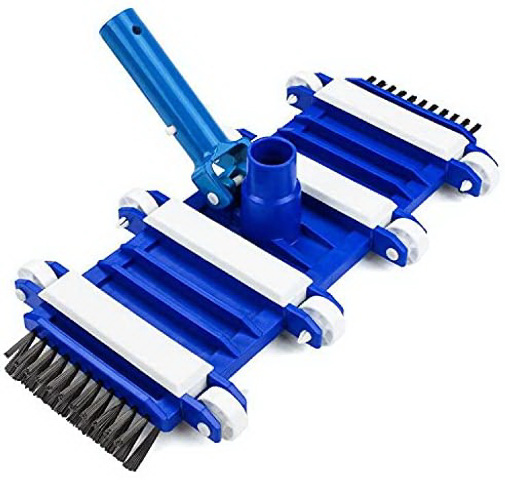
Click here to check price >>
This product fits a standard pool pole and uses a standard pool hose to suck up the dirt and leaves on the pool's floor.
When you vacuum your pool, make sure you set your filter's multiport valve to "waste". That will remove the debris and avoid clogging up your filter. And continually empty the skimmer basket of debris.
You may also need to brush the floor of your pool with a pool brush to loosen any dirt.
5. Run Your Filter Continuously
It's now time to explore the use of a water filter. Skimming collects larger debris, while filters collect small particles. Your pool water is likely a brown color and filtering will help to clear up the water.
How do filters work? Pool water filters are an effective mechanical process that works by separating water from particles. Water is pulled inside the filter container and goes through the filter medium (usually sand, diatomaceous earth (DE) or a cartridge) inside the filter.
During this process, debris and silt remain in the filter media while the clean water is released back to the pool. You'll need to backwash or clean your filter regularly as it will clog up quickly if you have muddy water.
Tip: Watch the filter gauge for high pressure – that's when it's time to clean your filter.
You'll need to alternate between vacuuming, skimming and filtering. This process will likely take a few days to clear up the water.
6. Add Flocculant to Clear the Water
Right now your pool water may look brown in color still – even after days of filtering and vacuuming. This is because there are tiny particles that are still suspended in the water, making it look brown and clouding the water.
Using a skimmer, vacuum and a filter will likely not remove these dirt and mud particles. This is where science comes in. There is a product called a flocculant.
When flocculant is poured into a muddy pool, the tiny particles of mud residue will draw together to form a larger clump and then sink to the bottom.
Now you can vacuum this up and run the filter to further clean the water.
You can use a pool floc like this one:

Click here to check price >>
7. Test balance the Water
Your water should be pretty clear now. It's time to test your water again. You want to make sure you have the correct pH, chlorine is at the correct level, alkalinity is good and you have cyanuric acid in your water.
For a full rundown on testing your water, you can follow post: How to Use Pool PH Testing Kit
Make sure you do your testing with a quality pool water test kit like this one:
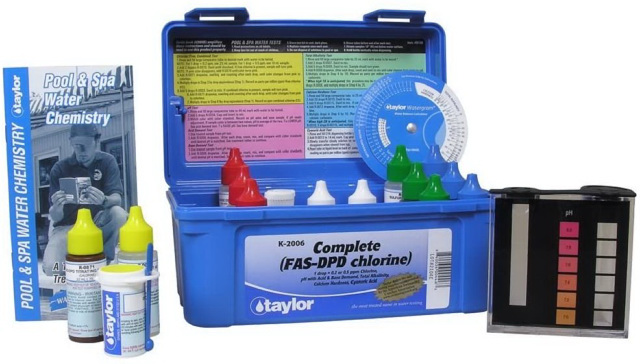
Click here to check price >>
Method 2: Partial or Fully Draining Pool to Remove Mud
Sometimes, there's so much mud and dirt in a pool that no amount of vacuuming and filtering will get it out.
If you've tried cleaning the pool as instructed above over the course of a couple of weeks and still have brown pool water, the best thing to do is partially or completely drain the pool water.
Most pools have a drainage system on the pool floor, but mud residue sitting on the bottom of the pool poses a greater risk of blocking the system, so a sump pump is often a better option.
The downside of this method of cleaning up a muddy pool is that all that water in the pool amounts to thousands of gallons and a substantial amount of money.
Here is how to go about it;
1. Clean the Pool Surrounds
Clean the deck or surrounds by picking up leaves and debris and sweeping up the dirt from the surrounding areas.
2. Use a Skimmer Net to Clean the Water Surface
When cleaning the pool, the first thing to always do is to skim through the water surface to collect or remove large floating debris.
3. Vacuum Large Debris from the Pool Floor
The next step is to vacuum up the pool using a vacuum cleaner. You don't want debris clogging up your pump or filter system when you start draining.
4. Drain the Pool
Some caution is needed here. You may have heard that draining your pool can cause serious damage. That is true. Your pool can actually pop up out of the ground causing major (and expensive) structural damage.
What should you do then?
Unless you're experienced we recommend you drain only half your pool's water. When you do this do not use your pool pump. You'll burn it out and secondly, when the water is below the skimmer, you'll start sucking in air.
Instead, use a submersible pump or a sump pump. You can buy or rent these. Simply turn it on and start pumping. Make sure you have a plan for where the water is going to go – you don't want to flood your house or your neighbors'.
The act of draining will take a lot of the dirt, which is suspended in the water, out.
5. Refill & Clean
Now that your pool is partially drained, you can refill it with the garden hose. If you're using well water, check out our article: insert our well water article here
6. Balance the Water
After refilling your pool, you'll need to add chlorine and chemicals to correct the pH and sanitizer levels.
7. Skim, Vacuum & Filter the Water
Even after draining you'll likely still have dirty water. You'll need to follow "Method 1: Filter, Vacuum & Floc to Clean Mud" as detailed above to complete the process.
To recap, skim debris from the surface with a net, use a pool vac to vacuum up dirt and debris from the pool floor (make sure you do this to waste), continuously filter the water and if necessary, add a flocculant to clear up the water.
Congratulations, you have successfully cleaned the mud out of your pool and have clean water!
What is The effect of mud on a pool?
The main objective when it comes to effective pool maintenance is to keep the chemicals balanced and contaminants out of the water. If you do this, the water remains as clear as glacial water.
That is why the clearest of pools bear no debris, stains, or funny pool water misbehavers.
Rainwater dilutes the chemical balance found in pool water and makes it hard for pool cleaning, such as the filter clogging up with the extra dirt.
Aside from water chemistry, muddy water can stain the bottom of the pool, making it appear dull and forever dirty.
What to Do After You Clear the Mud or Dirt
A dirty and muddy pool is gross and downright disgusting because everyone desires a super clean pool with the most transparent water in the neighborhood.
After clearing dirt and mud from your pool, here are tips on how to maintain a crystal clear pool;
- To maintain a clean pool, you must do a thorough weekly clean-up. It includes removing the debris on the water's surface, scrubbing off stains on the floor and sides of the pool, and vacuuming the pool at least once a week to maintain cleanliness.
- Pool water is all about pH balance – acidity vs. alkalinity of the water. Ensure that you keep the chemical balance of your pool in check.
- Ensure you adequately run your filter. You'll need to do this around 8 hours per day. Water circulation ensures that chemicals are well distributed and better filtration, therefore less debris and silt.
- It's crucial to maintain the right amount of sanitizer. For most pool owners that will be chlorine. Chlorine levels should be 2-5 ppm.
Final Thoughts
Dirt and mud get into pools all the time, and it is disheartening because it costs a whole lot of money and time to remove. But you can easily tackle this at home with basic skills and a bit of patience.
How To Clean A Very Dirty Pool
Source: https://www.myperfectpool.com.au/clean-mud-out-of-pool.html
Posted by: coxhusloncom.blogspot.com

0 Response to "How To Clean A Very Dirty Pool"
Post a Comment